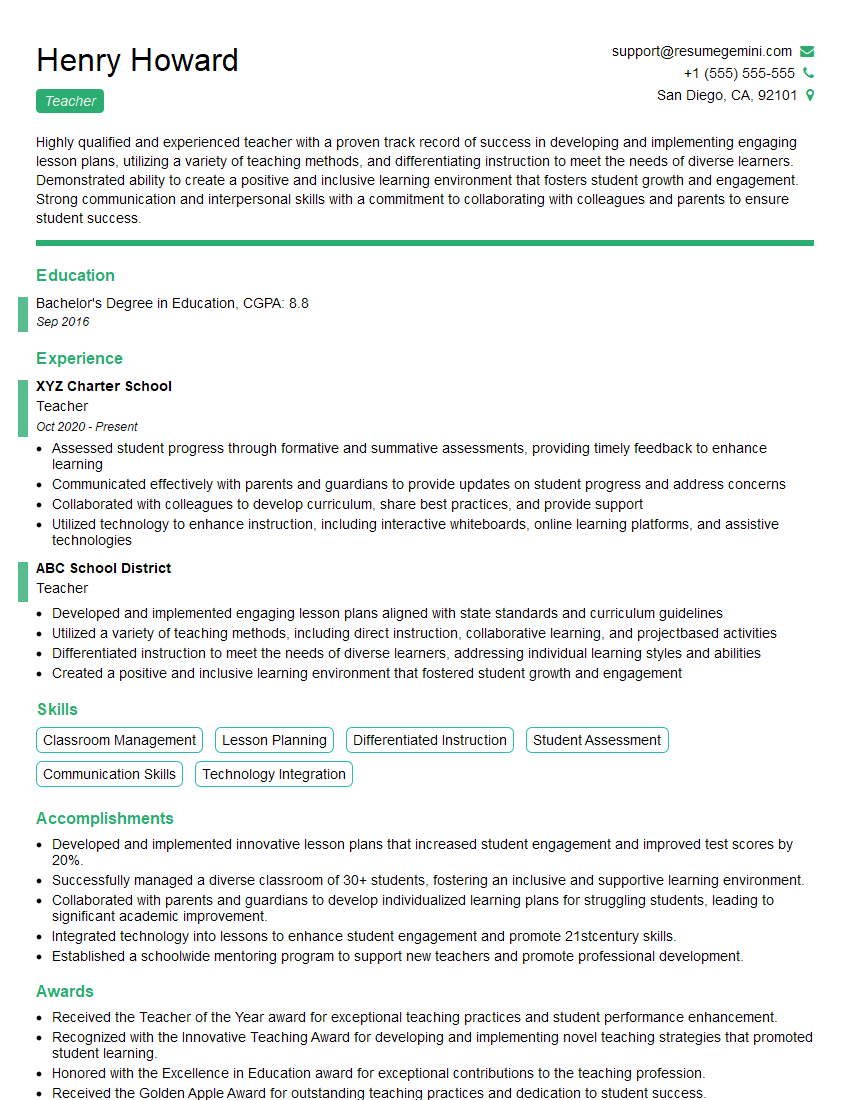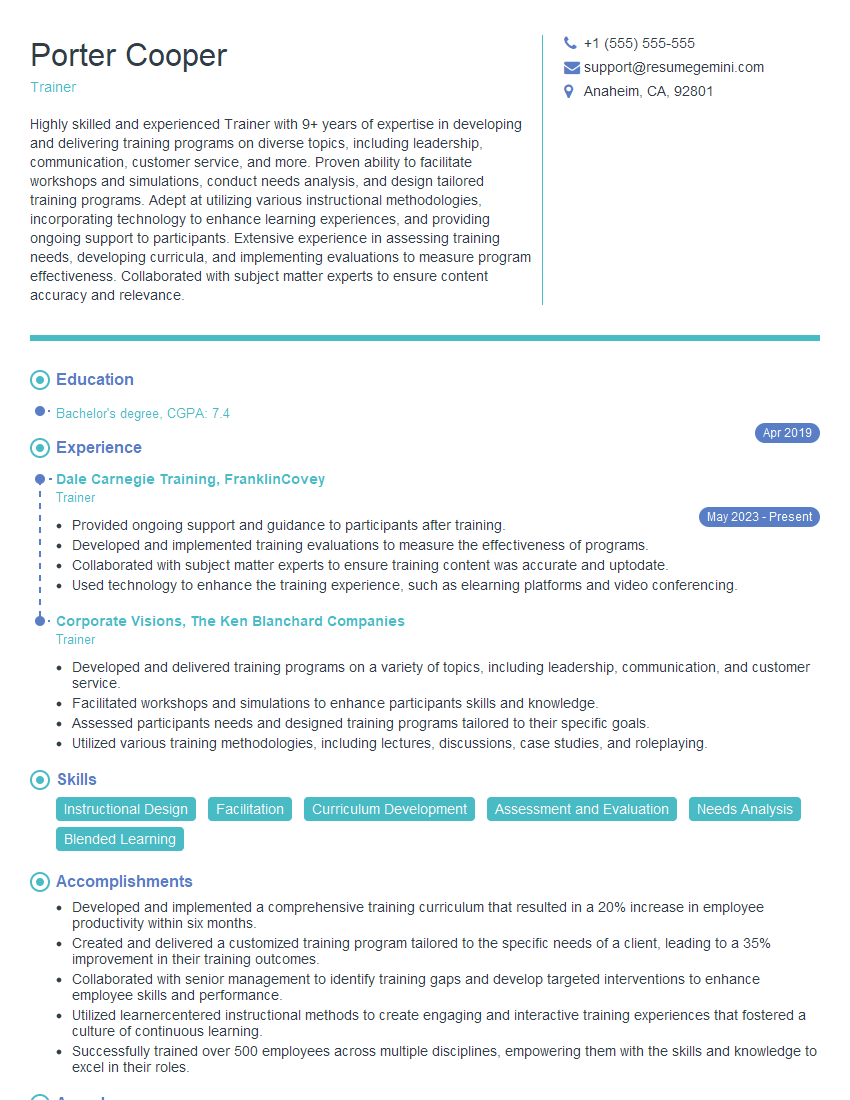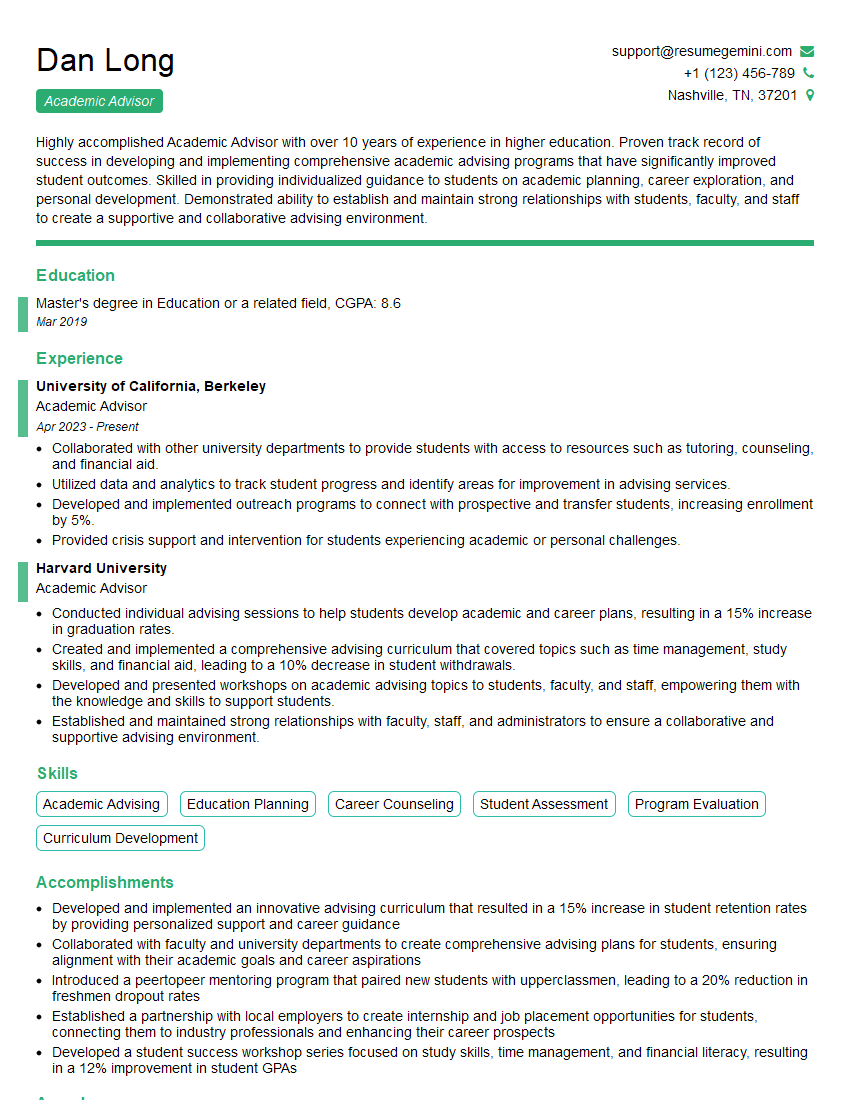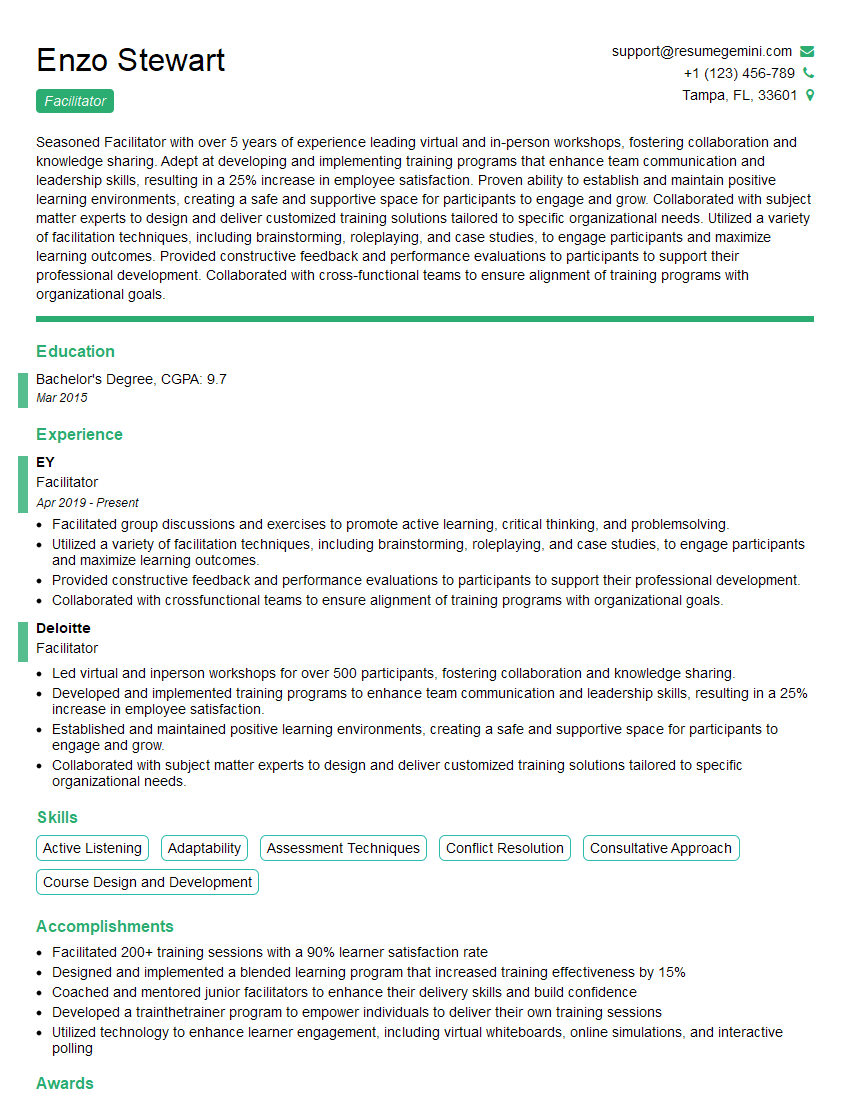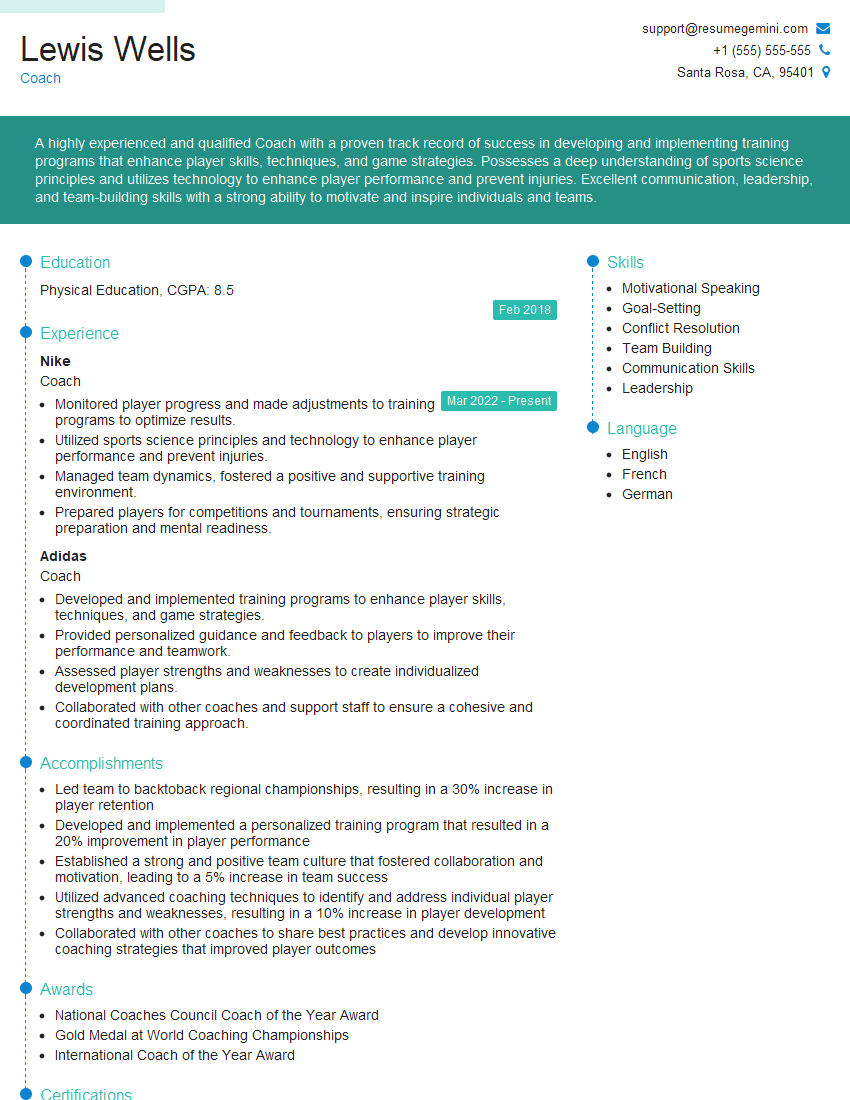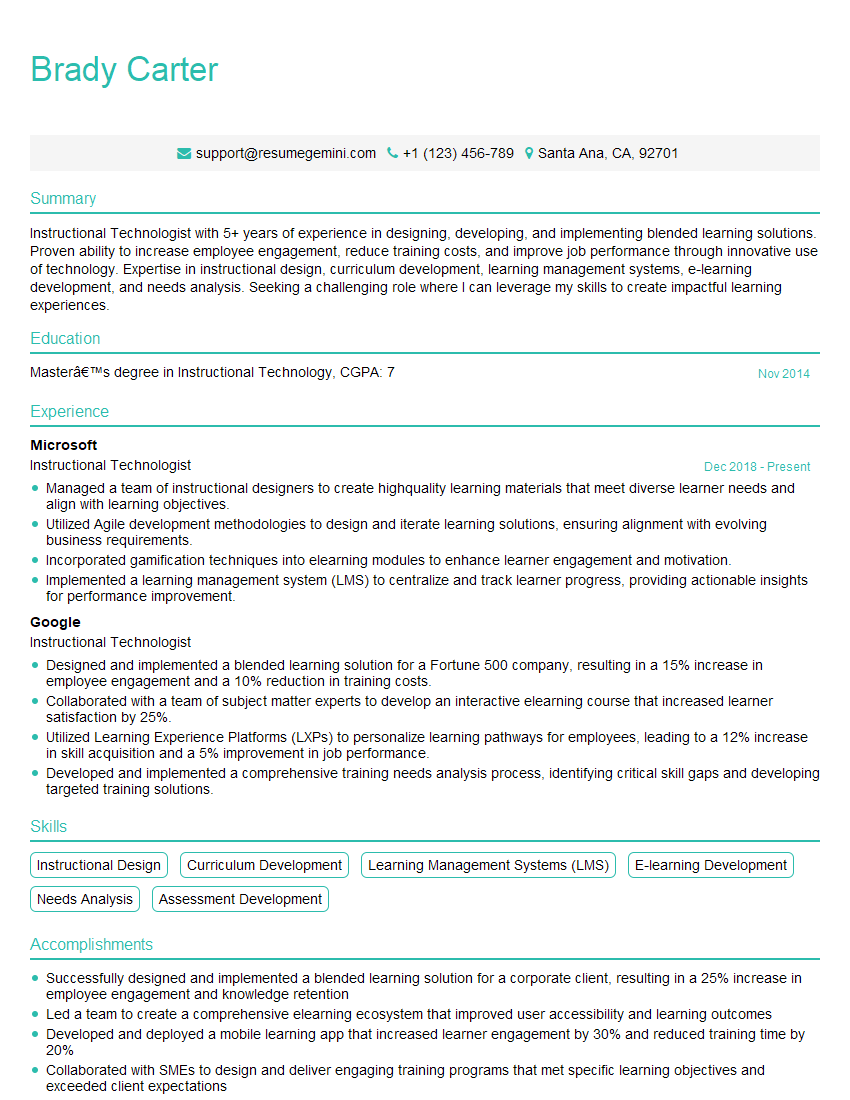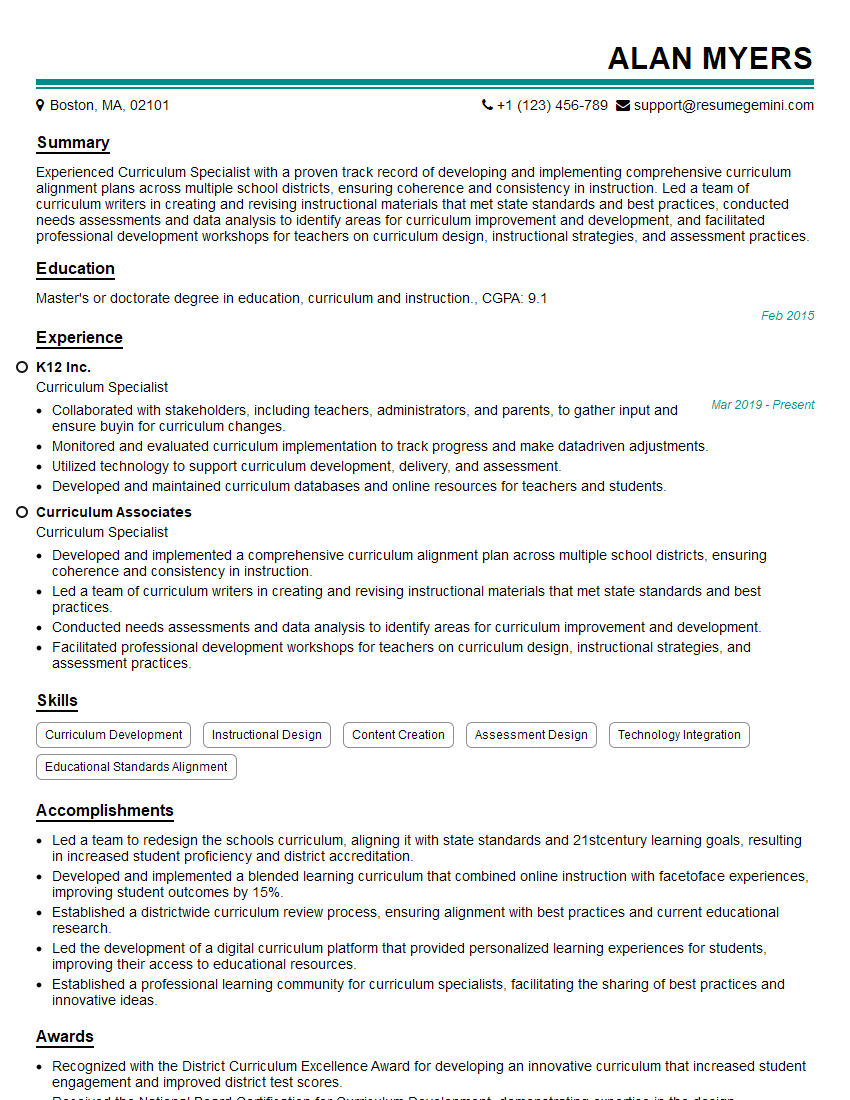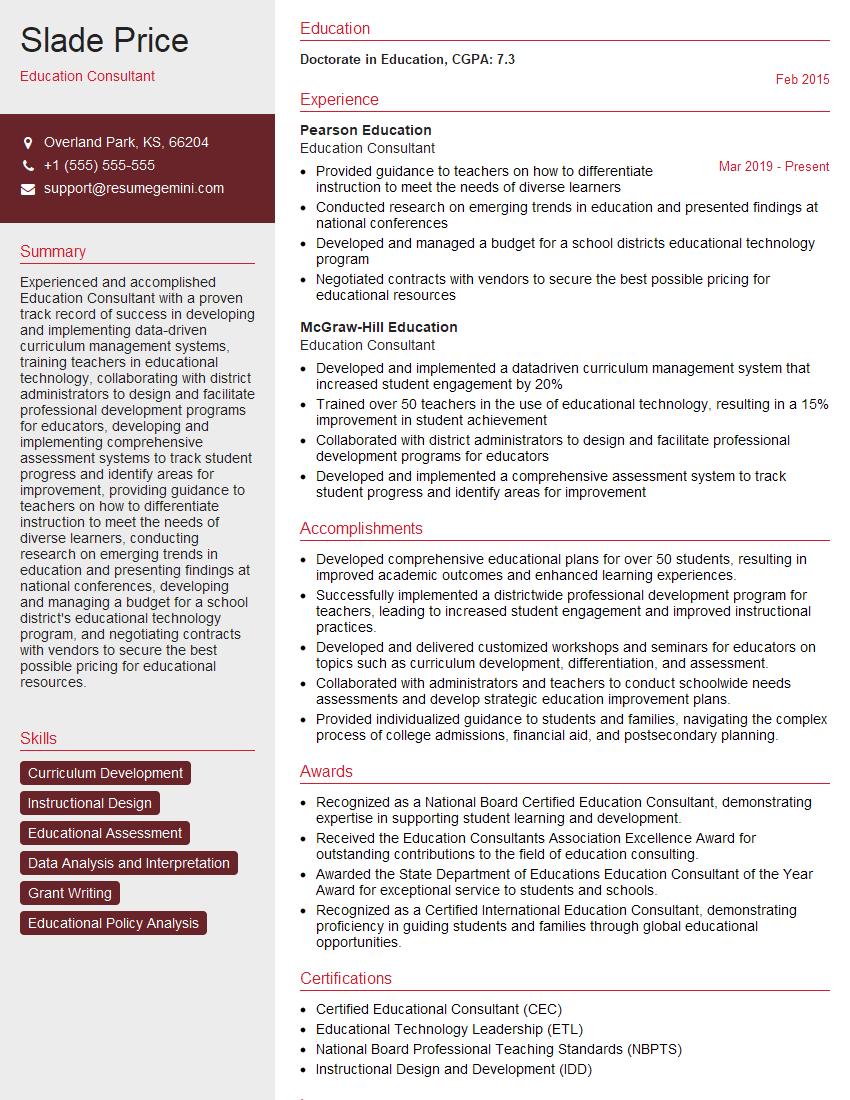The right preparation can turn an interview into an opportunity to showcase your expertise. This guide to Ability to create and maintain a positive and engaging learning environment interview questions is your ultimate resource, providing key insights and tips to help you ace your responses and stand out as a top candidate.
Questions Asked in Ability to create and maintain a positive and engaging learning environment Interview
Q 1. Describe your approach to fostering a collaborative learning environment.
Fostering a collaborative learning environment is crucial for deeper understanding and skill development. My approach involves strategically designing activities that encourage peer interaction and shared responsibility.
- Structured Group Work: I utilize various group work structures like Think-Pair-Share, jigsaw activities, and collaborative problem-solving projects. These activities require students to actively engage with each other, share ideas, and build upon each other’s knowledge. For example, in a science class, I might assign groups to design and build a model of a cell, requiring them to pool their knowledge and collaborate on the task.
- Shared Learning Goals: Clearly defining shared learning goals from the outset ensures everyone understands the collective objective. This promotes a sense of shared purpose and encourages mutual support.
- Positive Group Dynamics: I establish clear guidelines for respectful communication and collaboration, emphasizing active listening and constructive feedback. Regular check-ins and prompts for peer assessment help monitor group dynamics and address any challenges promptly.
- Technology Integration: Platforms like Google Docs or collaborative whiteboards allow for real-time collaboration, even outside of class. This promotes asynchronous learning and flexible teamwork.
Ultimately, my goal is to shift the learning paradigm from a solely teacher-centric model to one where learners actively participate in constructing knowledge together.
Q 2. How do you adapt your teaching style to meet the diverse learning needs of a group?
Adapting to diverse learning needs is paramount. I employ a multi-faceted approach that caters to various learning styles and preferences.
- Differentiated Instruction: I offer multiple pathways for accessing the material. This might include providing varied reading materials, offering choice in assignments (e.g., written reports, presentations, or projects), and using a combination of visual, auditory, and kinesthetic learning techniques.
- Individualized Learning Plans (ILPs): For students with significant learning differences or specific needs, I work closely with them and special education staff to create individualized learning plans. These plans outline specific learning objectives, accommodations, and support strategies tailored to their unique learning profiles.
- Universal Design for Learning (UDL): I design my lessons with UDL principles in mind, providing multiple means of representation (e.g., text, audio, video), action and expression (e.g., writing, drawing, speaking), and engagement (e.g., providing choices, incorporating students’ interests).
- Assessment Flexibility: I offer varied assessment options to accommodate different strengths and learning styles. This might include oral presentations, written exams, practical demonstrations, or portfolio assessments.
Regular communication with students and seeking their feedback are crucial for adapting my teaching strategies effectively. For instance, I might conduct informal polls or surveys to understand students’ preferred learning methods.
Q 3. Explain a time you had to manage disruptive behavior in a learning setting. What was your strategy?
In one instance, a student consistently disrupted class by talking out of turn and distracting others. My strategy involved a multi-step approach focusing on understanding the root cause and implementing positive behavioral interventions.
- Private Conversation: I first had a private conversation with the student to understand the underlying reasons for the disruptive behavior. It turned out the student was struggling with the material and felt frustrated.
- Positive Reinforcement: I then focused on positive reinforcement, praising the student when they engaged in appropriate behavior. I also provided extra support in the areas where they were struggling.
- Classroom Management Techniques: I utilized proximity control (moving closer to the student when they began to disrupt the class), non-verbal cues, and reminders of classroom expectations.
- Collaboration with Parents/Guardians: I contacted the student’s parents to share my observations and discuss strategies for consistent support at home.
By addressing the root cause, providing support, and consistently implementing positive behavioral strategies, I successfully managed the disruptive behavior. The key was to be patient, understanding, and to collaborate with the student and their family.
Q 4. How do you assess the effectiveness of your teaching methods and make adjustments?
Assessing the effectiveness of my teaching methods is an ongoing process. I use a variety of methods to gather data and make adjustments.
- Formative Assessments: Throughout the learning process, I utilize formative assessments like quizzes, exit tickets, and informal observations to monitor students’ understanding and identify areas needing improvement. This allows for real-time adjustments to my teaching.
- Summative Assessments: Summative assessments, such as tests and projects, provide a comprehensive evaluation of student learning at the end of a unit or course. The results inform my future teaching practices.
- Student Feedback: I regularly solicit student feedback through surveys, discussions, and individual conversations. This provides valuable insights into their learning experiences and helps me identify areas for improvement.
- Self-Reflection: I dedicate time to self-reflection, analyzing my lessons and identifying areas where I could enhance my teaching strategies. I keep a teaching journal to record my reflections and strategies.
- Data Analysis: I analyze assessment data to identify trends and patterns in student performance. This helps me to refine my teaching approaches and adapt to the specific needs of my students.
By continuously evaluating and adapting my teaching methods based on data and feedback, I aim to optimize the learning process for all students.
Q 5. What strategies do you use to encourage active participation from all learners?
Encouraging active participation from all learners requires a diverse range of strategies.
- Think-Pair-Share: This technique allows students to think individually, discuss with a partner, and then share with the whole class, promoting active participation even from quieter students.
- Small Group Discussions: Breaking the class into smaller groups encourages more students to contribute and share their thoughts.
- Interactive Activities: Games, simulations, role-playing, and other interactive activities can increase engagement and participation.
- Polls and Surveys: Using technology like online polls or quick surveys can gauge understanding and encourage students to express their views anonymously.
- Creating a Safe Space: A positive and supportive classroom environment is essential for encouraging participation. Students need to feel comfortable sharing their ideas and opinions without fear of judgment.
- Cold Calling (with care): Strategically calling on students, especially those who are less likely to volunteer, can encourage participation, but it’s crucial to do so in a supportive and non-threatening way.
By employing a mix of these strategies and continuously adapting based on student responses, I strive to create a classroom where every student feels empowered to actively participate.
Q 6. How do you incorporate technology to enhance the learning experience?
Technology offers powerful tools for enhancing the learning experience. I strategically integrate technology to increase engagement, accessibility, and effectiveness.
- Interactive Whiteboards: Interactive whiteboards facilitate engaging presentations and collaborative activities, allowing students to participate actively in the learning process.
- Educational Software and Apps: I utilize educational software and apps tailored to different subjects and learning styles. For example, simulations can make abstract concepts more concrete, while educational games can make learning fun and engaging.
- Online Learning Platforms: Learning Management Systems (LMS) like Moodle or Canvas provide structured online learning environments, facilitating access to course materials, assignments, and communication tools.
- Multimedia Resources: Videos, podcasts, and interactive simulations can enhance understanding and cater to different learning styles.
- Collaborative Tools: Google Docs, collaborative whiteboards, and other tools allow for real-time group work and facilitate seamless communication among students.
However, I prioritize thoughtful integration. Technology serves as a tool to enhance learning, not replace meaningful interaction and engagement.
Q 7. How do you create a sense of community and belonging in your classroom/training setting?
Building a sense of community and belonging is vital for a positive learning environment. I approach this through various strategies.
- Icebreakers and Team-Building Activities: At the start of a course or program, I use icebreakers and team-building activities to help students get to know each other and build rapport.
- Collaborative Projects: Collaborative projects encourage teamwork and shared responsibility, fostering a sense of collective accomplishment.
- Open Communication: I create a classroom culture that encourages open communication and mutual respect, where students feel comfortable sharing their ideas and concerns.
- Classroom Discussions: Regular classroom discussions offer opportunities for students to express their opinions, listen to others, and learn from each other’s perspectives.
- Celebrating Successes: Recognizing and celebrating individual and group achievements fosters a sense of pride and belonging.
- Creating a Physically Welcoming Space: The physical classroom or learning environment should be welcoming, organized, and reflect the inclusive nature of the learning community.
By fostering a culture of respect, collaboration, and shared success, I aim to create a learning environment where every student feels valued, supported, and connected to the wider learning community.
Q 8. Describe your approach to providing constructive feedback to learners.
Constructive feedback is crucial for learner growth. My approach focuses on being specific, timely, and balanced, emphasizing both strengths and areas for improvement. I avoid generalizations and instead pinpoint specific behaviors or actions. For instance, instead of saying ‘Your presentation was poor,’ I might say, ‘Your presentation was engaging, but the conclusion could be strengthened by summarizing the key findings more concisely.’ I always frame feedback positively, focusing on what the learner can do to improve, rather than dwelling on shortcomings. I also encourage a two-way dialogue, inviting learners to share their perspectives and understanding of the feedback.
I often use a structured feedback framework, like the ‘STAR’ method (Situation, Task, Action, Result), which helps learners understand the context and impact of their actions. I also provide actionable steps, suggesting concrete strategies for improvement. Finally, I schedule follow-up sessions to track progress and provide additional support, ensuring that the feedback isn’t a one-time event but rather a catalyst for ongoing development.
Q 9. How do you differentiate instruction to meet the needs of learners at different skill levels?
Differentiated instruction is key to catering to diverse learning styles and skill levels. I use a multifaceted approach, incorporating varied teaching methods, materials, and assessment strategies. For instance, I might offer tiered assignments, where learners select tasks based on their proficiency level. Beginner-level tasks might focus on foundational concepts, while more advanced tasks challenge learners to apply their knowledge creatively. I also utilize flexible grouping strategies, sometimes using homogeneous grouping (learners with similar skill levels) for focused instruction and heterogeneous grouping (learners with diverse skill levels) for collaborative learning and peer support.
I also employ diverse learning materials. For visual learners, I might incorporate diagrams and videos. For kinesthetic learners, I might use hands-on activities or simulations. Regular formative assessments, like quick quizzes or exit tickets, allow me to monitor learner understanding in real-time and adjust my instruction accordingly. This ensures that all learners, regardless of their starting point, are challenged appropriately and have the opportunity to succeed.
Q 10. How do you manage time effectively to ensure all learning objectives are met?
Effective time management is vital for achieving learning objectives. My approach involves meticulous planning and flexible execution. Before each session, I create a detailed lesson plan outlining specific activities, timelines, and assessment strategies. This plan acts as a roadmap, ensuring that I cover all essential topics within the allotted time. However, I also build in flexibility, recognizing that unexpected questions or discussions might arise. I might use techniques like timeboxing, allocating a specific amount of time for each activity, to keep things on track.
Furthermore, I utilize various time-saving strategies such as pre-preparing materials, utilizing technology effectively (e.g., online resources, interactive simulations), and encouraging active learner participation through engaging activities. Regularly monitoring progress against the lesson plan helps me to identify any potential time constraints and make necessary adjustments throughout the session. Post-session reflection allows me to refine my time management strategies for future sessions.
Q 11. How do you deal with learner frustration or disengagement?
Learner frustration or disengagement is a common challenge that requires a sensitive and proactive approach. I start by identifying the root cause. Is it the material, the pace of instruction, a lack of understanding, or something else entirely? Once I’ve identified the source, I tailor my response. Sometimes, it’s a matter of simplifying complex concepts, offering additional support, or providing more opportunities for practice. Other times, it might involve addressing emotional factors—perhaps the learner is feeling overwhelmed or insecure.
I create a safe and supportive learning environment where learners feel comfortable asking questions and seeking help. I use positive reinforcement and encouragement to boost confidence. If the issue persists, I might involve parents or guardians, or seek support from colleagues or specialists. The goal is always to understand the learner’s perspective, address their concerns, and help them regain their motivation and enthusiasm for learning. A simple strategy I find effective is to break down large tasks into smaller, more manageable steps, offering praise and encouragement along the way.
Q 12. How do you create assessments that accurately reflect learner understanding?
Accurate assessment reflects learner understanding and informs future instruction. I use a variety of assessment methods, including formative assessments (like quizzes and class discussions) to track progress during the learning process and summative assessments (like tests and projects) to evaluate overall learning outcomes. The key is to align assessments with learning objectives, ensuring that they accurately measure what has been taught. For example, if the learning objective is to analyze data, the assessment might involve a data analysis problem or a case study requiring data interpretation.
I strive for a balance between objective and subjective assessment methods. Objective assessments, like multiple-choice tests, provide quantifiable data, while subjective assessments, such as essays or presentations, assess higher-order thinking skills and allow for more nuanced evaluation. I also consider the format of the assessment, ensuring it is accessible and appropriate for the learners’ skill levels and needs. Regularly reviewing and refining assessment methods based on learner feedback and results is crucial for ensuring accuracy and fairness.
Q 13. Describe a time you had to deal with conflict among learners. How did you resolve it?
I once had a conflict between two learners in a group project. One learner felt the other wasn’t contributing their fair share, leading to tension and resentment. My approach was to create a safe space for them to express their concerns. I facilitated a structured conversation, emphasizing active listening and encouraging each learner to articulate their perspective without interruption. I guided them towards identifying the root cause of the conflict and collaboratively brainstorming solutions.
We established clear roles and responsibilities for each learner, ensuring that everyone had a well-defined contribution. We also implemented regular check-in points to monitor progress and address any emerging issues promptly. This collaborative approach not only resolved the immediate conflict but also fostered better communication and teamwork among the group members. The experience highlighted the importance of proactive conflict resolution and creating a positive and inclusive classroom environment.
Q 14. How do you incorporate real-world examples or case studies into your teaching?
Integrating real-world examples and case studies enhances learner engagement and understanding. I regularly incorporate current events, news articles, and case studies relevant to the subject matter. For example, while teaching about financial markets, I might analyze recent market trends or discuss a real-life investment strategy. When teaching about environmental issues, a case study on a successful conservation project can illustrate the practical application of the concepts.
I also encourage learners to bring their own real-world experiences into the learning process. Discussions and activities centered around their personal observations and anecdotes help them connect the concepts to their own lives, making the learning more meaningful and memorable. This approach fosters a deeper understanding and helps learners see the relevance of the subject matter to their future careers and lives beyond the classroom.
Q 15. How do you use formative assessment to guide your instruction?
Formative assessment is like taking the temperature of the classroom – it’s ongoing feedback that helps me adjust my instruction to better meet student needs. I use a variety of techniques, including:
- Quick checks: Short quizzes, exit tickets, or informal polls during class to gauge understanding of key concepts. For example, after explaining a complex equation, I might ask students to solve a simple problem applying that equation and briefly share their answers with a neighbor.
- Observations: Paying attention to student engagement during activities and discussions. If I notice many students struggling with a particular task, I adjust my approach or provide additional support.
- Think-pair-share: Students work together to discuss a problem or question, allowing me to observe their reasoning and identify areas needing clarification.
- Interactive whiteboards/digital tools: Using technology to gather immediate feedback through polls, quizzes, or collaborative documents.
The data gathered informs my next steps. If many students miss a key concept, I revisit the topic using a different method, provide additional practice, or offer one-on-one support.
Career Expert Tips:
- Ace those interviews! Prepare effectively by reviewing the Top 50 Most Common Interview Questions on ResumeGemini.
- Navigate your job search with confidence! Explore a wide range of Career Tips on ResumeGemini. Learn about common challenges and recommendations to overcome them.
- Craft the perfect resume! Master the Art of Resume Writing with ResumeGemini’s guide. Showcase your unique qualifications and achievements effectively.
- Don’t miss out on holiday savings! Build your dream resume with ResumeGemini’s ATS optimized templates.
Q 16. How do you promote self-directed learning among your students?
Promoting self-directed learning empowers students to take ownership of their education. I foster this by:
- Providing choice: Offering students options in projects, assignments, or learning activities, allowing them to pursue topics that genuinely interest them. For instance, in a history class, students might choose to research a specific historical figure or event that aligns with their interests.
- Setting clear learning goals: Collaboratively establishing clear learning objectives with students, ensuring they understand the expectations and the steps to achieve them. This helps them understand their progress and feel a sense of accomplishment.
- Teaching learning strategies: Explicitly instructing students in effective learning strategies, such as time management, note-taking, and self-assessment techniques. This helps them develop independent learning habits.
- Facilitating independent research: Providing access to resources and guiding students on how to conduct research and evaluate information critically. This equips them with the skills to explore topics independently.
- Using project-based learning: Engaging students in long-term projects that require them to manage their time, research information, and collaborate with others, fostering autonomy and self-reliance.
Q 17. What are your strategies for motivating learners who lack intrinsic motivation?
Motivating learners lacking intrinsic motivation requires understanding the root cause. It’s often not about lack of ability, but rather a lack of connection to the material, a sense of helplessness, or a lack of confidence. My strategies include:
- Building relationships: Establishing a positive and supportive classroom environment where students feel respected and valued. This creates a safe space for learning and risk-taking.
- Connecting learning to real-world applications: Showing students the relevance of the material to their lives and future goals. For example, demonstrating how mathematical concepts are used in everyday life or showcasing the impact of historical events on the present day.
- Providing opportunities for success: Breaking down complex tasks into smaller, more manageable steps, allowing students to experience a sense of accomplishment along the way. Positive reinforcement is crucial.
- Offering choices and autonomy: Allowing students some control over their learning process can increase engagement and motivation. This might involve choosing project topics, selecting assessment methods, or determining the pace of learning.
- Celebrating effort and progress: Recognizing and acknowledging students’ efforts, not just their achievements, fostering a growth mindset and boosting their self-efficacy.
Q 18. How do you maintain a positive and enthusiastic demeanor even when faced with challenges?
Maintaining a positive demeanor even during challenging times is crucial for creating a supportive learning environment. I do this by:
- Self-care: Prioritizing my own well-being through adequate rest, exercise, and stress-management techniques. A well-rested and healthy teacher is better equipped to handle challenges.
- Mindfulness and perspective: Practicing mindfulness to manage my emotions and reactions. Remembering the bigger picture—my commitment to student success—helps me to maintain a positive outlook even when facing setbacks.
- Seeking support: Connecting with colleagues, mentors, or administrators to share challenges and receive guidance. Collaboration and support can be invaluable.
- Focusing on solutions: Instead of dwelling on problems, I focus on finding solutions. This proactive approach helps maintain energy and prevents negativity from overwhelming the classroom.
- Celebrating small victories: Acknowledging small successes, both mine and my students’, helps to boost morale and maintain a positive attitude.
Q 19. How do you ensure inclusivity and accessibility for all learners?
Inclusivity and accessibility are paramount. I ensure all learners feel valued and supported by:
- Differentiated instruction: Adapting my teaching methods and materials to meet the diverse needs of my students. This includes providing different learning options, varying the level of support, and utilizing varied assessment methods.
- Utilizing assistive technology: Employing assistive technologies such as text-to-speech software, screen readers, or graphic organizers, as needed, to support learners with disabilities.
- Creating a welcoming classroom environment: Establishing a classroom culture that embraces diversity and respects individual differences. This includes promoting open communication and celebrating the unique contributions of each student.
- Collaborating with support staff: Working closely with special education teachers, counselors, and other support staff to ensure students receive the appropriate accommodations and support.
- Culturally responsive teaching: Integrating diverse perspectives and experiences into my curriculum and instructional practices, ensuring all students see themselves reflected in the learning materials.
Q 20. Describe your process for planning and organizing learning materials.
Planning and organizing learning materials is a crucial step. My process involves:
- Setting learning objectives: Clearly defining the learning outcomes I want students to achieve. This guides the selection and sequencing of materials.
- Selecting appropriate resources: Choosing a variety of engaging and relevant materials, such as textbooks, articles, videos, and interactive simulations. I consider the diverse learning styles of my students when making these selections.
- Organizing materials logically: Structuring the learning materials in a way that is easy to follow and promotes a clear understanding of the concepts. I might use mind maps, outlines, or other graphic organizers to visually represent the information.
- Creating engaging activities: Developing interactive activities, such as group projects, discussions, and hands-on experiments, to enhance student engagement and participation.
- Assessing materials for accessibility: Ensuring that all learning materials are accessible to all students, including those with disabilities. This includes providing alternative formats and utilizing assistive technologies.
Q 21. How do you use technology to enhance communication with learners and parents/supervisors?
Technology plays a significant role in enhancing communication. I use:
- Learning Management Systems (LMS): Platforms like Canvas or Moodle to share assignments, announcements, grades, and resources. This provides a central hub for communication and allows for easy access to materials.
- Email and messaging apps: To send timely updates, answer individual student questions, and communicate directly with parents/supervisors.
- Video conferencing: Tools like Zoom or Google Meet facilitate virtual office hours, individual meetings with students, or parent-teacher conferences.
- Educational apps and websites: Integrating educational apps or websites into instruction to enhance learning experiences and provide additional practice opportunities. This could involve interactive simulations, games, or online quizzes.
- Parent portals: Utilizing LMS features or dedicated parent portals to keep parents/supervisors informed of their child’s progress, assignments, and upcoming events.
Transparent and consistent communication through multiple channels builds strong relationships and fosters a collaborative learning environment.
Q 22. How do you build rapport with learners?
Building rapport with learners is crucial for creating a positive and engaging learning environment. It’s about establishing trust and mutual respect, making learners feel comfortable and valued. I achieve this through several key strategies:
- Active Listening and Showing Genuine Interest: I make a conscious effort to listen attentively to learners’ concerns, questions, and perspectives. I ask follow-up questions to show genuine interest in their thoughts and experiences. For example, instead of just hearing a student say they’re struggling with a concept, I’ll ask, “Can you tell me more about what’s specifically challenging you?” This helps me understand their individual needs better.
- Creating a Safe and Inclusive Space: I foster a classroom culture where everyone feels safe to participate, ask questions, and share their ideas without fear of judgment. This includes establishing clear ground rules for respectful communication and actively challenging any instances of disrespect or exclusion.
- Learning Learner Names and Using Them: Knowing learners’ names and using them regularly helps me personalize the learning experience and build a connection with each individual. It’s a simple yet powerful way to show that I care about them as individuals.
- Using Humor Appropriately: Injecting humor (when appropriate) can lighten the mood and make learning more enjoyable. However, it’s crucial to be mindful of cultural differences and ensure that the humor is inclusive and respectful.
- Sharing Personal Anecdotes (when relevant): Occasionally sharing relevant personal anecdotes can help learners connect with me on a human level and make the learning material more relatable. For instance, if we’re discussing problem-solving, I might share a personal experience of overcoming a challenge.
Q 23. Explain your approach to providing support to learners who are struggling.
My approach to supporting struggling learners is multifaceted and focuses on identifying the root cause of their difficulties and providing tailored assistance. I start by:
- Identifying the Specific Challenges: I use various assessment methods (quizzes, observations, one-on-one conversations) to pinpoint exactly where the learner is struggling. Is it a lack of foundational knowledge, a misunderstanding of concepts, or something else entirely?
- Providing Differentiated Instruction: Once I’ve identified the challenges, I provide differentiated instruction, adapting my teaching methods and materials to meet the learner’s specific needs. This might involve offering extra practice, providing alternative explanations, using different teaching modalities (visual, auditory, kinesthetic), or breaking down complex tasks into smaller, more manageable steps.
- Offering Additional Support and Resources: I connect struggling learners with additional support resources such as tutoring, online learning platforms, or study groups. I also encourage them to seek help from peers or mentors.
- Building Confidence and Motivation: It’s important to foster a supportive and encouraging environment where learners feel comfortable asking for help without fear of judgment. I regularly praise effort and progress, focusing on their strengths and celebrating their achievements, however small.
- Regular Check-ins and Feedback: I maintain regular check-ins with struggling learners to monitor their progress and provide ongoing support. I also provide constructive feedback on their work, emphasizing areas for improvement and celebrating successes.
For instance, if a student is struggling with algebra, I might start by assessing their understanding of basic arithmetic. If there’s a gap, I’ll work with them on that foundational knowledge before moving on to more advanced concepts. I might also use visual aids or manipulatives to help them visualize the concepts.
Q 24. How do you measure the impact of your teaching on learner outcomes?
Measuring the impact of my teaching on learner outcomes is essential for continuous improvement. I use a variety of methods to assess this impact, including:
- Formative Assessments: These assessments are conducted throughout the learning process to monitor learner progress and identify areas needing improvement. Examples include quizzes, class discussions, and short assignments.
- Summative Assessments: These assessments measure overall learner achievement at the end of a unit or course. Examples include exams, projects, and presentations.
- Learner Feedback: I regularly solicit learner feedback through surveys, focus groups, or individual conversations. This provides valuable insights into their learning experience and identifies areas for improvement.
- Analyzing Learner Data: I analyze data from assessments and feedback to identify trends and patterns in learner performance. This helps me identify areas where my teaching is effective and areas that need improvement.
- Observing Learner Engagement: I observe learner engagement during classes and activities. This provides insights into how effectively my teaching methods are engaging learners and promoting active participation.
By combining these methods, I gain a comprehensive understanding of the impact of my teaching and can make informed decisions about how to improve my instruction. For example, if I notice a consistent drop in scores on a particular topic, I might revise my lesson plan for that topic or incorporate different teaching strategies.
Q 25. How do you adapt your teaching to different learning styles?
Adapting my teaching to different learning styles is paramount to ensuring all learners have the opportunity to succeed. I acknowledge that learners process information in different ways, encompassing visual, auditory, kinesthetic, and reading/writing preferences. My approach involves:
- Diverse Teaching Methods: I employ a variety of teaching methods to cater to different learning styles. This includes lectures, discussions, group work, hands-on activities, visual aids (like diagrams and videos), and multimedia presentations.
- Offering Choice and Flexibility: I provide learners with choices in how they demonstrate their understanding. For instance, learners might choose to write an essay, create a presentation, or develop a project to showcase their knowledge.
- Providing Varied Learning Materials: I use a range of learning materials, including textbooks, articles, videos, and online resources, to appeal to different learning preferences. For example, providing both written instructions and a video demonstration of a procedure caters to visual and auditory learners.
- Incorporating Technology: Technology offers powerful tools for differentiated instruction. Interactive simulations, online quizzes, and educational games cater to different learning preferences and can make learning more engaging.
- Understanding Individual Needs: I actively seek to understand individual learning preferences through informal discussions, observations, and learning style assessments. This personalized approach allows for targeted instruction.
For example, when teaching about the solar system, I might use visual aids like posters and models for visual learners, play audio recordings of space sounds for auditory learners, and incorporate hands-on activities like building models of planets for kinesthetic learners.
Q 26. Describe a time you had to develop a new curriculum or lesson plan.
I recently developed a new curriculum for a course on digital literacy for senior citizens. The existing curriculum was outdated and lacked engagement for this specific demographic. My approach involved:
- Needs Assessment: I conducted interviews and surveys with potential learners to understand their existing digital skills, their learning preferences, and their specific needs. This highlighted a strong need for hands-on, practical activities and a less technical approach.
- Curriculum Design: Based on my needs assessment, I designed a curriculum that incorporated a gradual learning curve, focusing on practical applications rather than technical jargon. The curriculum included modules on using email, navigating the internet, online banking, and social media, with a strong emphasis on safety and security.
- Interactive Activities: I incorporated a variety of interactive activities, such as group exercises and real-world case studies, to make learning more engaging and relevant. For example, we simulated online shopping scenarios to practice safe online transactions.
- Technology Selection: I carefully selected user-friendly technology and software to eliminate unnecessary complexity. We used large-font interfaces and provided hands-on support throughout the sessions.
- Feedback and Iteration: I regularly solicited feedback from learners throughout the course and made adjustments to the curriculum and teaching methods based on their input.
The result was a highly successful curriculum that empowered senior citizens with essential digital skills, resulting in significantly higher completion rates and positive feedback from the participants.
Q 27. What are your strategies for incorporating learner feedback into your teaching?
Incorporating learner feedback is crucial for refining my teaching and creating a more effective learning environment. My strategies include:
- Regular Feedback Mechanisms: I use various methods to collect feedback, including anonymous surveys, informal discussions, and feedback forms after assignments or projects. These provide diverse perspectives.
- Analyzing Feedback Themes: I carefully analyze the feedback, identifying recurring themes and trends. This helps me understand what’s working well and what needs improvement.
- Actionable Changes: Based on the analysis, I make specific, actionable changes to my teaching. This might involve revising lesson plans, adjusting assessment methods, or modifying the learning environment.
- Transparency and Communication: I’m transparent with learners about how their feedback is used to improve the learning experience. This builds trust and shows that their opinions are valued.
- Follow-up: I follow up with learners to address their concerns and demonstrate that their feedback has been heard and acted upon. This reinforces the importance of their input.
For example, if learners consistently indicate that a particular topic is confusing, I might revise my explanation, incorporate different teaching strategies, or provide additional resources.
Q 28. How do you evaluate the effectiveness of your learning environment?
Evaluating the effectiveness of my learning environment is an ongoing process that involves assessing multiple aspects. My approach includes:
- Learner Engagement: I observe learner participation, attentiveness, and overall enthusiasm for learning. Are learners actively involved in discussions, completing assignments, and seeking clarification?
- Classroom Climate: I assess the overall classroom climate, paying attention to the level of respect, trust, and collaboration among learners. Is the atmosphere conducive to learning and interaction?
- Learning Outcomes: I monitor learner achievement through assessments and feedback. Are learners meeting the learning objectives? Are they demonstrating mastery of the subject matter?
- Learner Feedback: As mentioned earlier, learner feedback provides critical insights into the effectiveness of the learning environment. What aspects are working well? What needs improvement?
- Self-Reflection: I regularly reflect on my own teaching practices, considering what’s working well and what could be improved. This is crucial for continuous improvement.
By using a combination of these methods, I get a holistic picture of the learning environment and can make adjustments to ensure it’s optimal for learner success. For instance, if learner engagement is low, I might try incorporating more interactive activities or adjusting the pacing of the course.
Key Topics to Learn for Ability to create and maintain a positive and engaging learning environment Interview
- Understanding Learning Styles and Needs: Explore different learning styles (visual, auditory, kinesthetic) and how to adapt your teaching methods to cater to diverse learners. Consider individual learning needs and potential barriers to learning.
- Creating a Safe and Inclusive Classroom: Discuss strategies for fostering a respectful and supportive environment where all students feel comfortable participating and contributing. Address methods for managing disruptive behavior constructively.
- Engaging Instructional Strategies: Explore active learning techniques such as group work, discussions, projects, and games. Explain how to incorporate technology effectively to enhance engagement.
- Providing Effective Feedback and Assessment: Discuss different methods for providing constructive feedback that promotes learning and growth. Explain how to design assessments that accurately measure student understanding and progress.
- Building Rapport and Relationships: Discuss the importance of establishing positive relationships with students based on trust and mutual respect. Highlight techniques for active listening and empathy.
- Classroom Management Techniques: Explore proactive and reactive strategies for managing classroom behavior and maintaining a productive learning environment. Consider different classroom structures and their impact on student engagement.
- Adapting to Different Contexts: Discuss how to adapt your teaching style and strategies to different learning environments, such as online learning, hybrid models, or diverse classroom settings.
- Promoting Collaboration and Teamwork: Explore strategies for encouraging collaboration and teamwork among students, fostering a sense of community and shared learning.
- Utilizing Technology for Enhanced Learning: Discuss the ethical and effective integration of technology to support and enhance the learning experience, including accessibility considerations.
- Reflecting on Practice and Seeking Professional Development: Emphasize the importance of continuous improvement and professional development to enhance teaching skills and create engaging learning environments.
Next Steps
Mastering the ability to create and maintain a positive and engaging learning environment is crucial for career advancement in education and related fields. It demonstrates your commitment to student success and your capacity to inspire and motivate learners. To significantly boost your job prospects, focus on crafting an ATS-friendly resume that highlights your skills and experience in this area. ResumeGemini is a trusted resource to help you build a professional and impactful resume. Examples of resumes tailored to showcasing your abilities in creating and maintaining positive and engaging learning environments are available to guide you.
Explore more articles
Users Rating of Our Blogs
Share Your Experience
We value your feedback! Please rate our content and share your thoughts (optional).
What Readers Say About Our Blog
There are no reviews yet. Be the first one to write one.

